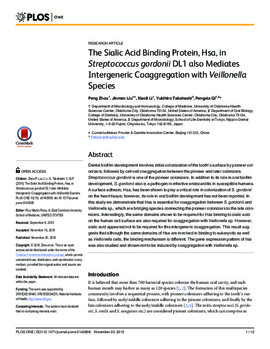| dc.contributor.author | Peng Zhou | |
| dc.contributor.author | Jinman Liu | |
| dc.contributor.author | Xiaoli Li | |
| dc.contributor.author | Yukihiro Takahashi | |
| dc.contributor.author | Fengxia Qi | |
| dc.date.accessioned | 2017-03-05T22:55:23Z | |
| dc.date.available | 2017-03-05T22:55:23Z | |
| dc.date.issued | 2015-11-25 | |
| dc.identifier.citation | Zhou P, Liu J, Li X, Takahashi Y, Qi F (2015) The Sialic Acid Binding Protein, Hsa, in Streptococcus gordonii DL1 also Mediates Intergeneric Coaggregation with Veillonella Species. PLoS ONE 10(11): e0143898. doi:10.1371/journal.pone.0143898 | en_US |
| dc.identifier.uri | https://hdl.handle.net/11244/49282 | |
| dc.description | | en_US |
| dc.description | | en_US |
| dc.description.abstract | Dental biofilm development involves initial colonization of the tooth’s surface by pioneer colonizers, followed by cell-cell coaggregation between the pioneer and later colonizers. Streptococcus gordonii is one of the pioneer colonizers. In addition to its role in oral biofilm development, S. gordonii also is a pathogen in infective endocarditis in susceptible humans. A surface adhesin, Hsa, has been shown to play a critical role in colonization of S. gordonii on the heart tissue; however, its role in oral biofilm development has not been reported. In this study we demonstrate that Hsa is essential for coaggregation between S. gordonii and Veillonella sp., which are bridging species connecting the pioneer colonizers to the late colonizers. Interestingly, the same domains shown to be required for Hsa binding to sialic acid on the human cell surface are also required for coaggregation with Veillonella sp. However, sialic acid appeared not to be required for this intergeneric coaggregation. This result suggests that although the same domains of Hsa are involved in binding to eukaryotic as well as Veillonella cells, the binding mechanism is different. The gene expression pattern of hsa was also studied and shown not to be induced by coaggregation with Veillonella sp. | en_US |
| dc.language.iso | en_US | en_US |
| dc.publisher | PLos One | |
| dc.relation.ispartofseries | PLoS ONE 10(11): e0143898 | |
| dc.relation.uri | http://www.plosone.org/article/info%3Adoi%2F10.1371%2Fjournal.pone.0143898 | |
| dc.rights | Attribution 3.0 United States | |
| dc.rights.uri | https://creativecommons.org/licenses/by/3.0/us/ | |
| dc.subject | Adhesins,Sialic acids,Cell binding,Species colonization,Streptococcus,Gene expression,Luciferase,Plasmid construction | en_US |
| dc.title | The Sialic Acid Binding Protein, Hsa, in Streptococcus gordonii DL1 also Mediates Intergeneric Coaggregation with Veillonella Species | en_US |
| dc.type | Research Article | en_US |
| dc.description.peerreview | Yes | en_US |
| dc.description.peerreviewnotes | http://www.plosone.org/static/editorial#peer | en_US |
| dc.identifier.doi | 10.1371/journal.pone.0143898 | en_US |
| dc.rights.requestable | false | en_US |

